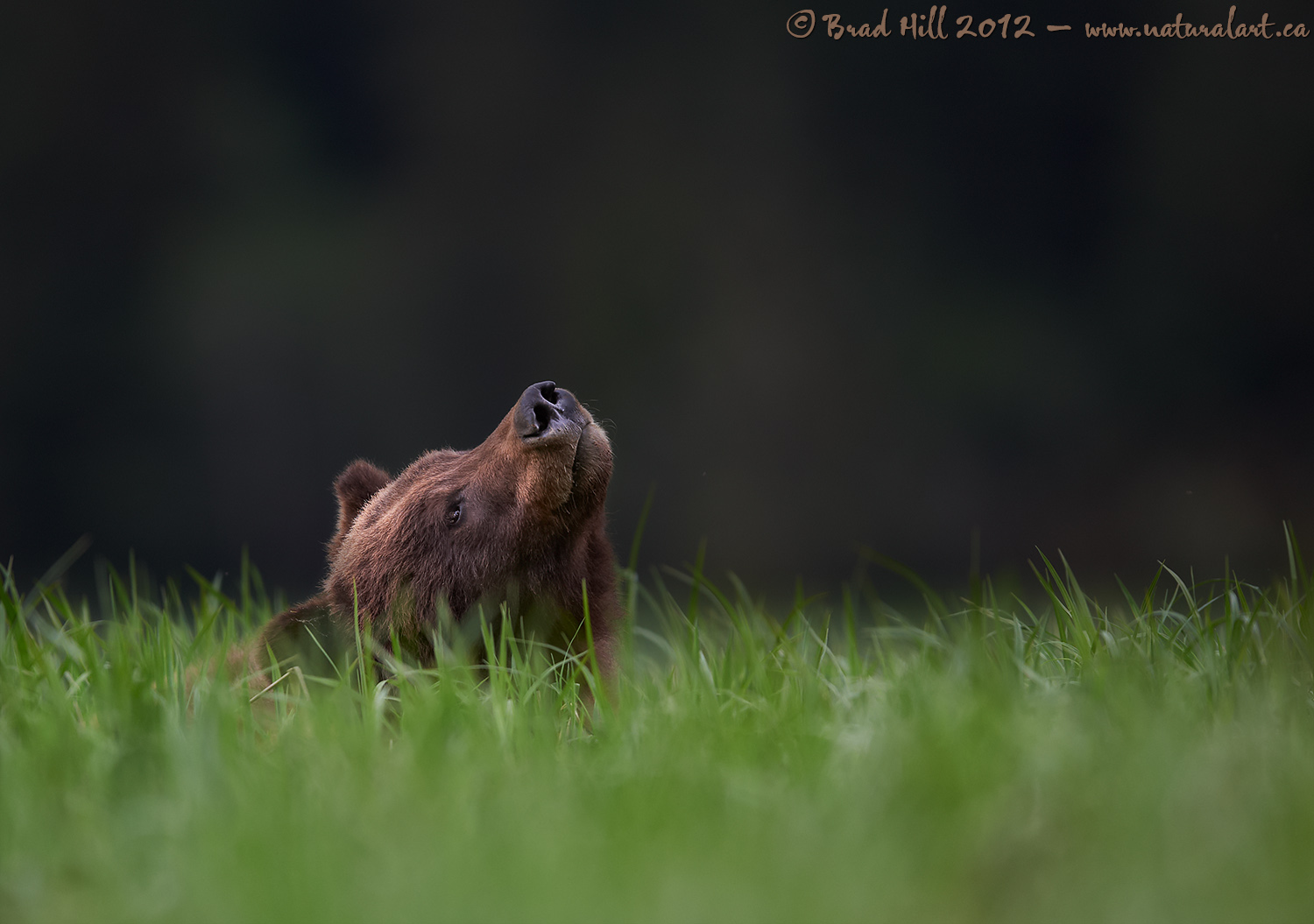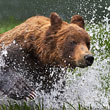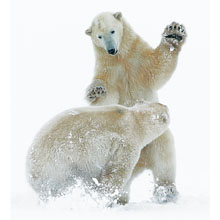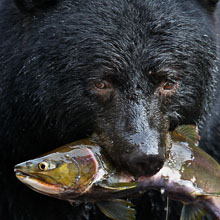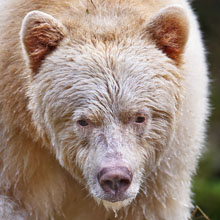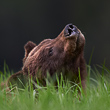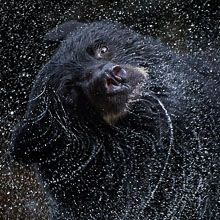Availability: Undetermined - Enquiries?
In the Field
An Eye Out. Khutzeymateen Grizzly Sanctuary, Great Bear Rainforest, BC, Canada. May 26, 2012.
Anyone who has spent a lot of time watching bears, and specifically watching them sleep, will know that they're quite different from us. When it comes to sleeping, they don't seem to ever afford themselves the luxury we strive for - that is, zonking right out and forgetting about the world. Even in their soundest sleep their ears are always pivoting around, always listening for sounds. I guess when you could be attacked at any time (be it from a larger bear, a wolf, or a human with a gun) it pays to stay alert. Kind of makes the worries that fill our heads on sleepless nights seem pretty trivial...
We watched this bear "sack out" on a grass-covered island in the middle of the estuary at the top end of the Khutzeymateen Inlet. The grass was deep enough to obscure the bear from sight, especially when you were at ground level (like I obviously was when I shot this). But, despite dozing off, every few minutes the bear would raise its head, scan around to ensure the coast was clear, and then lower its head again. Always, always keeping an eye out. I have no doubt that once its head was down those ears were pivoting away!
Whenever I get back from a photo tour I email out a few images that I processed during the trip to a few friends (before I roll up my sleeves and really dig into the images). This one seemed especially popular - CBC Radio even chose to feature it on their website. When I shot this image I really liked what I saw through the viewfinder and knew how the 400mm f2.8 lens I was using would render the shot (just like this!). But what I really like about this shot is that it nicely encapsulates my "philosophy" and/or approach to wildlife photography. Those who were on the instructional photo tour with me when I shot this image will be able to particularly relate to this! And, those of you who were with me and wondered what the heck I was doing when I was contorted on the bottom of the Zodiac shooting this will now know! So...
1. "Simplify and Isolate". When I'm in the field the mantra I'm chanting in my head is almost always "Simplify and isolate, simplify and isolate..." Simplify your composition - while its theoretically possible to have an image ruined by being TOO simple, in practice the reverse is almost always true - images are often ruined by having too many elements compete for your eyes' attention. Not many elements here - 3 at most! And, isolate your subject (from distractions, from the background, etc.). Make it pop!
2. Overlay Simple Compositional Principles. We all know about the standard compositional guidelines - everything from using leading lines to giving your subject room to breathe through to the rule of thirds. It would be had to find an image than conforms more to the rule of thirds - notice where the foreground/background split is (rule of thirds application #1) and notice where the bear is positioned horizontally AND vertically (rule of thirds application #2).
3. The Power of Visual Contrast. Things that are different in any way (be it in colour, brightness, sharpness...whatever) stand out. Here I used focus contrast (complete with a shallow depth of field) to almost force the viewer to look at the bear (don't you just HATE being manipulated??). I'm betting that most viewer's eyes went instantly to the bear's nose hear, and then moved to the eye and then eventually to the in-focus blades of grass. No accident!
4. Fall OUT of Love With Your Subject (temporarily). Many (if not most) intermediate to advanced amateur wildlife photographers know the 3 "rules" above. BUT, the minute they're faced by a powerful and dominating subject in a field setting, they forget it all and just snap documentary shots. There's NOTHING wrong with documentary shots, but they don't often turn into wall-hangers, contest-winners, or generate much revenue. So...for at least a few moments, fall OUT of love (or awe, or fear!) of your subject and just think of it AS A SUBJECT (maybe a banana, or a flower pot) and get your photographic brain in gear! I'm always amazed by how many super-well informed photographers know everything about photography (really!) but somehow forget to apply it in the field!
Rant over. Now I'm just going to go back to loving looking at bears! ;-)
Here's a higher resolution (2400 pixel) version of the shot for those wanting to see more detail:
• An Eye Out Download 2400 pixel image (JPEG: 0.8 MB)
ADDITIONAL NOTES:
1. This image - in all resolutions - is protected by copyright. I'm fine with personal uses of them (including use as desktop backgrounds or screensavers on your own computer), but unauthorized commercial use of the image is prohibited by law. Thanks in advance for respecting my copyright!
2. This image was captured during one of my two spring "Grizzlies of the Khutzeymateen" photo tours in May/June of 2012. Each year I offer trips into two different parts of the Great Bear Rainforest as well as one to photograph aquatic mammals and oceanscapes near the northern tip of Vancouver Island. And, in selected years, I also offer photo tours to locations to capture other highly sought-after subjects, such as various boreal owl species and wildlife of Canada's Arctic. Details about these trips can be found on the Photo Tours page of this website.
3. Like all wildlife photographs on this website, this image was captured following the strict ethical guidelines described in The Wildlife FIRST! Principles of Photographer Conduct. I encourage all wildlife photographers to always put the welfare of their subjects above the value of their photographs.
Behind the Camera
An Eye Out. Khutzeymateen Grizzly Sanctuary, Great Bear Rainforest, BC, Canada. May 26, 2012.
Digital Capture; Compressed RAW (NEF) 14-bit format; ISO 800.
Nikon D4 paired with Nikkor 400mm f2.8 VRII lens. Hand-held from floating Zodiac. VR on and set to "normal" mode.
1/400s @ f3.2; -0.33 stop compensation from matrix-metered exposure setting. Auto ISO engaged with Auto shutter speed enabled (shutter speed keyed to focal length of lens with no compensation).
At the Computer
An Eye Out. Khutzeymateen Grizzly Sanctuary, Great Bear Rainforest, BC, Canada. May 26, 2012.
RAW Conversion to 16-bit TIFF, including first-pass/capture sharpening using Capture One Pro. Three raw variants (processed from raw) differing by a total of 1.0 stops in exposure.
Further digital corrections on resulting 16-bit TIFF files using Adobe's Photoshop CS6 and Light Craft's Lightzone. Photoshop adjustments including compositing the raw conversion variants (layering and masking), and selective sharpening for web output. Final tone tweaking performed using tonemapper/re-light tool in Lightzone.
Conservation
An Eye Out. Khutzeymateen Grizzly Sanctuary, Great Bear Rainforest, BC, Canada. May 26, 2012.
Ten percent of the revenue generated by this image will be donated to Raincoast*.
Species Status in Canada**: Special Concern (May 2002).
While Grizzly Bears (Ursus arctos) are not technically listed as "Endangered" in Canada, they have been extirpated from most of their historical range. Grizzly Bears are far more sensitive to intrusion/disturbance in their habitat than are Black Bears and are being increasingly forced into marginal habitat by human encroachment. The Great Bear Rainforest along the central and northern coast of British Columbia is one of the last strongholds of the Grizzly Bear in Canada, and even this population is coming under increasing pressure.
On December 18, 2017 the government of British Columbia banned grizzly hunting across the entire province. This major conservation victory came after decades of tireless work by many dedicated conservationists and ecologists and, most importantly, it reflects the opinion of the vast majority of British Columbians. And, it means that AT LEAST while the current government remains in power grizzlies are finally "safe" in British Columbia.
Now that we've at least temporarily won the battle to save grizzlies in BC, it's time to re-focus our efforts toward protecting ALL of BC's carnivores, including Gray Wolves, Black Bears, Cougars, Wolverines, and more! Simply put, there are no ecological, economic, or ethical arguments supporting the trophy hunting of carnivores.
In a great first step towards ending the hunting of carnivores throughout BC the Raincoast Conservation Foundation has developed a program designed to protect ALL carnivores within the Great Bear Rainforest. Details about this program can be found on this page on Raincoast's website. Check it out and, better yet, make a donation to help Raincoast purchase the remaining commercial hunting tenures in the Great Bear!
*The Raincoast Conservation Society (and Foundation) is an effective and efficient organization that has been fighting for protection of this unique habitat. If you are looking for a meaningful way to contribute to the conservation of this amazing ecosystem, Raincoast will provide maximal "bang" for your conservation dollars.
**as determined by COSEWIC: The Committee on the Status of Endangered Wildlife in Canada












